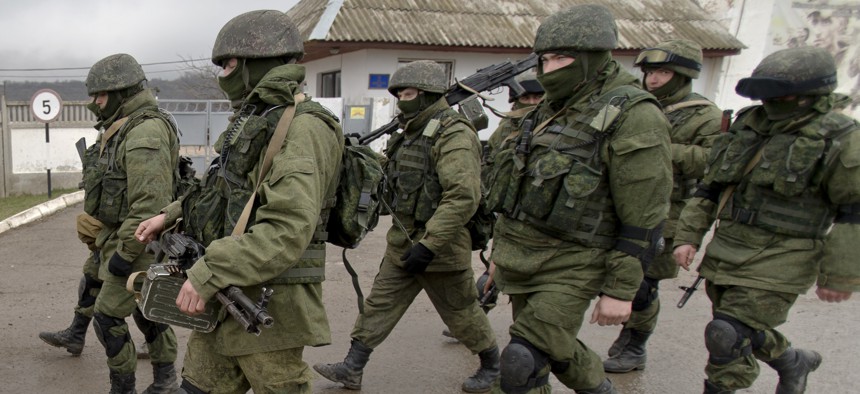
In this March 20, 2014 file photo Pro-Russian soldiers march outside an Ukrainian military base in Perevalne, Crimea. AP Photo/Vadim Ghirda
Here's the US Army's New Russia-Era Shopping List
After Putin's Ukraine invasion, the Army's future command wants longer guns, better cybersecurity, and a new way to buy weapons.
Russia’s invasion of Ukraine forced the U.S. Army to rethink its needs, from better cyber security to longer-ranged artillery cannons, according to the commander of the service’s new Futures Command.
“That was kind of the wake-up call in terms of the capabilities that the Russians had been developing since about the time of Desert Storm,” said Gen. John Murray.
Most prominently, Murray said, is Russian — and also Chinese — progress in “establishing standoff capabilities” — that is, the ability to strike from greater distances than the U.S. Army.
He said the Russians — and in many ways the Chinese as well — are "able to outrange most of our systems.”
Related: Foreign Weapons Get a Closer Look as the Pentagon Races to Rearm
Related: The US Army’s in Good Shape, But Tough Choices Loom
Related: How Russia’s Sub-Launched Missiles Threaten NATO’s Wartime Strategy
The U.S. Army has raced to keep up. Just last week, it tested a modified M777A2 howitzer that “doubled the range” of its cannon artillery, firing a round “62-ish kilometers” at Yuma Proving Ground, Murray said.
“I think if you looked at the Russian army now and started counting artillery pieces they probable still have a slight advantage in terms of quantities,” the general said. “Quality, I would still argue, we’ve got the edge, but the range thing — they had developed some capabilities that really out-ranged our tactical cannon artillery.”
Many similar efforts are likely as the Army looks to re-invest $25 billion into its top weapons priorities, which largely deal with the “great power competition” with Russia and China that is laid out in the National Defense Strategy.
Murray said Russia has paired drones with artillery systems, “almost using drones as spotters.”
Russia is getting better at employing its forces, using operations in Syria as a proving ground for new weapons, a senior European defense official said in a recent interview. European officials have been surprised by the operational tempo Russia has been able to sustain, particularly being able to quickly maintain and repair its equipment.
“The Russians have made some significant advances, not only in terms of the capabilities but in terms of their organizational structure and their tactics,” Murray said. “That really … was a wake-up call, if nothing else, to start looking at this in a more serious manner, which has led us into what you’re seeing now in the National Defense Strategy, a focus on near-peer competitors.”
